
The heart chakra (anahata chakra in Sanskrit) is one of seven major centers of concentrated energy located in the body. It’s also referred to as the fourth chakra, heart center, or green chakra.
According to yogic anatomy, the chakras ascend along the spinal column from the base of the spine to the crown of the head. Each of these energy centers is responsible for controlling unique aspects of our physical, mental, emotional, and spiritual well-being.
The heart chakra is the seat of the soul. It’s the place where your gifts and intentions originate. And it is the energy center of empathy, compassion, and unity.
In this article, we’ll explore the different qualities of the heart chakra and how they relate to the body, mind, and spirit. You will also learn ways to connect with, heal, strengthen, and balance anahata chakra.
Table of Contents

In Sanskrit, anahata translates to “unstruck” and can also mean “unhurt” or “unbeaten.” This term relates to the heart chakra because according to vedic scriptures, the sound of the universe (called anahata nad or “unstruck sound”) exists in our heart center. The idea behind this concept is that through inner silence and an open heart, it’s possible to access this cosmic sound vibration. This inner sound connects us with all of existence.
It’s no surprise that the heart chakra energizes the areas of our lives concerning love and compassion. It relates to the element of air, the colors green and pink, and our sense of touch. The Hindu deities Shiva and Shakti are also associated with the heart chakra.
As we briefly mentioned, each chakra controls the energies that relate to certain physical, psychological, and spiritual parts of ourselves. Here are some of the connections between anahata chakra and our lives:
The heart chakra is located along the spinal column at the level of the anatomical heart. Its kshetram, or corresponding trigger point on the surface of the body, is at heart level in the center of the chest.
In the physical body, the fourth chakra is related to our:
Anahata chakra is also connected to the:
Since the heart is linked to our sense of touch, its corresponding sensory organs are the skin and the hands.

The heart chakra governs love ‒ both personal and universal. It also controls our sense of self-acceptance and how we connect with ourselves and others. Additionally, anahata chakra is associated with gratitude, generosity, and healing.
According to yogic philosophy, there are 12 divine qualities of the heart (vrittis) that are governed by anahata chakra. These 12 qualities are: peace, love, bliss, compassion, empathy, harmony, understanding, purity, clarity, unity, kindness, and forgiveness.
The heart chakra is the balancing point between the three lower chakras (root, sacral, and solar plexus) and the three higher chakras (throat, third eye, and crown). In the chakra system, the lower chakras connect us to the physical world and the higher chakras connect us to the cosmos. Thus, anahata chakra is the meeting place between body and spirit. In other words, it serves as a bridge between personal identity and universal consciousness.
The area around the anatomical heart is also related to the concept of hridaya ‒ the spiritual heart. According to vedic texts, hridaya is the seat of consciousness and the home of the true self. The spiritual heart is different from the heart chakra. In fact, it transcends all of the chakras and encompasses the entire universe. However, anahata chakra is connected to hridaya as its equivalent in the energetic body.
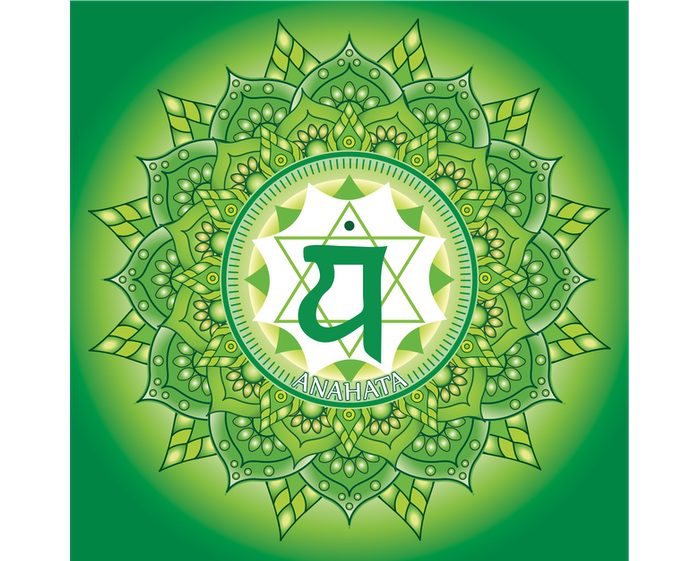
Each of the main chakras is represented symbolically by a lotus flower-shaped mandala. The anahata chakra symbol is a green lotus with 12 petals. In this symbol, the lotus petals represent the 12 qualities of the heart (listed in the previous section).
The center of the anahata mandala contains a six-pointed star. This star, formed by an upward-pointing and a downward-pointing triangle, symbolizes the meeting of the higher and lower chakras. The triangles also illustrate the convergence of Shiva (divine masculine) and Shakti (divine feminine) energy and, respectively, of matter and consciousness.
Green represents Earth, growth, life, harmony, balance, expansion, and love. According to color therapy, it’s a hue that calms our minds and makes us feel nourished. Furthermore, as the fourth color of the rainbow spectrum, green corresponds to the fourth chakra.

When a chakra is in its optimal state, we manifest its positive characteristics. Therefore, a balanced anahata chakra is associated with:

Our seven chakras are described as energetic vortexes that are connected through various channels. Therefore, even one blocked chakra affects the flow of prana, our vital life force energy, to the entire body.
Physical, mental, and emotional issues can all affect anahata chakra. However, by recognizing the symptoms of heart chakra imbalances, you can identify and heal problems at their source.

Fortunately, there are several methods for consciously purifying the chakras. Techniques for healing, balancing, or “opening” different parts of the energetic body include:
In the following sections, we’ll explain how to connect with and balance anahata chakra using these techniques.
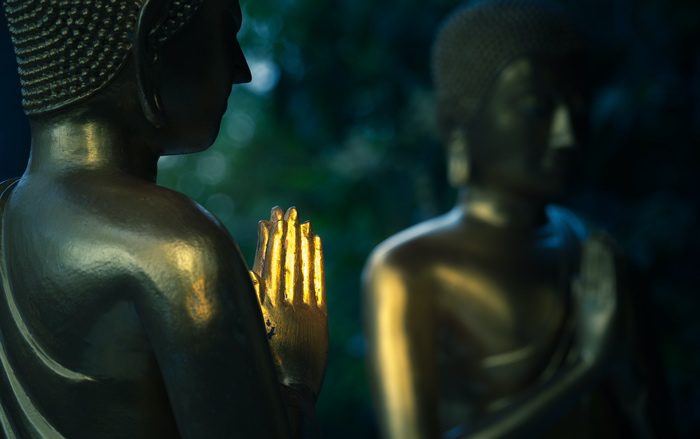
Mantras are syllables, words, or intentions that we can use to focus the mind through repetition. Furthermore, Sanskrit mantras connect us to vibrational patterns that help us access specific parts of our consciousness. To use the following heart chakra mantras, either chant them out loud or silently recite them in your mind. You can also set an intention for the mantra to improve a specific anahata-related issue.
Each chakra has a one-syllable bija mantra or “seed sound” that resonates at the same frequency as that chakra. When you chant the bija mantra for anahata chakra, you strengthen your connection to your heart center.
The bija mantra for the heart chakra is yam (pronounced to rhyme with mom).
Om mani padme hum is the Tibetan Buddhist mantra of love and compassion. Chanting these words can enhance these qualities in yourself. However, you can also use this mantra to share heart-related qualities with others.
The most basic translation of om mani padme hum is “The jewel is in the lotus.” However another interpretation is “I am remembering the cosmic divine jewel that is within my lotus heart.” Either way, the mantra points towards the concept that the essence of our true selves resides in the spiritual heart.
“Ra Ma Da Sa” is a well-known mantra because of Yogi Bhajan, who popularized kundalini yoga in the west. It’s known as the mantra for healing yourself and others using universal life force energy. This is an ability associated with a healthy heart chakra.
Heart Chakra Affirmations
Affirmations are positive statements that guide our minds and bodies towards a set goal or intention. To work with an affirmation, you can speak it aloud, repeat it silently, or write it down.
An affirmation to strengthen the fourth chakra can be something basic like, “My heart is open.” However, it can also be therapeutic to create affirmations that resonate with personal heart-related aspects of your life.
Here are some examples of affirmations to strengthen heart chakra imbalances:
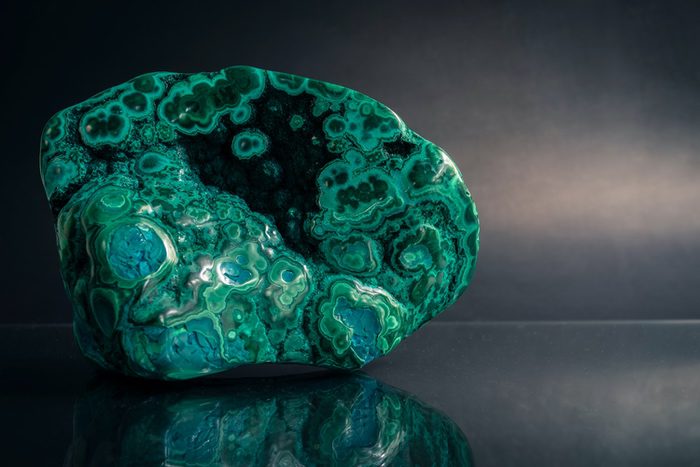
Stones and crystals that are the symbolic color of each chakra serve to purify or direct energy to that chakra. Therefore, fourth chakra stones are typically green, the main color of anahata chakra. Pink is a secondary color of the heart chakra. Accordingly, pink crystals are often used to balance anahata chakra as well. Examples of heart-chakra stones include:
Some ways to utilize stones or crystals to balance the heart chakra are:

Essential oils recommended to balance the heart chakra are typically calming, nurturing, and light. They are often floral in nature.
Recommended essentials oils to balance anahata chakra include:
There are various methods for using essential oils. However, for connecting with your heart center, try placing a drop of oil on your sternum above your heart center or massaging a few drops into your palms.

Meditation and guided concentration practices can benefit all of your chakras and areas of life. Specific techniques for working with anahata chakra include:
Visualize a green light glowing at your heart center. Use your mind’s eye to envision this light radiating throughout your body and providing you with kindness, forgiveness, and universal love ‒ towards yourself and others.
The Buddhist practice of Metta, or “loving kindness,” meditation, increases our capacity for selfless love and compassion. To practice metta, begin by visualizing something at your heart center that helps you feel connected to love. This could be anything, such as a flame, lotus flower, personal symbol of kindness, spiritual teacher, partner, child, pet, etc.
As you sit in meditation, imagine this sense of love growing larger and larger. Visualize it filling your heart center first, then your torso, and then your entire body. Continue to expand this love to the space around you. Then, envision spreading it to your family and friends, your community, your country, the world, the universe, and beyond.
Feel yourself connect to love’s limitless expanse. Then, slowly, step-by-step, shrink this sense of love back into your heart center, knowing that you hold its infinite potential within you at all times.
Chant or silently recite one of the heart chakra affirmations or mantras above. As you do this, set the intention to increase or balance heart-centered energy.
Mudras are energetic seals that we can make with the body, primarily the hands, in order to control how prana flows. Here are some examples of mudras that help direct energy to anahata chakra:
Anjali Mudra
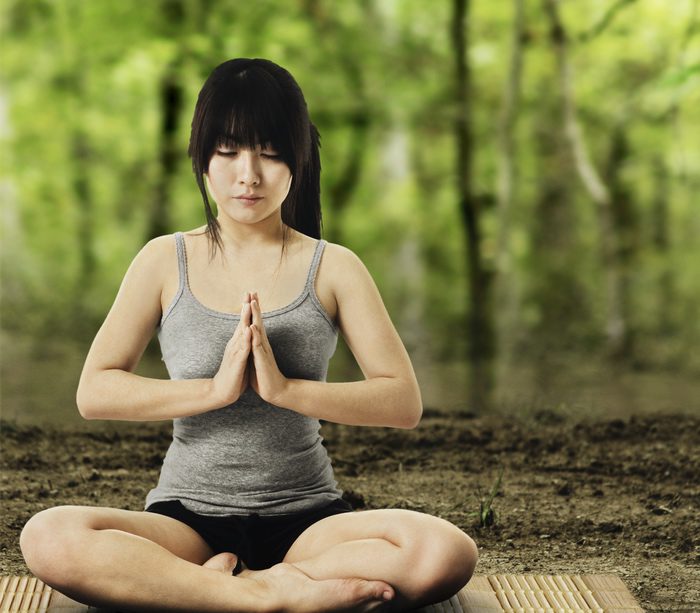
Anjali mudra is also known as “prayer position” or “namaste.” To practice this mudra, place your hands together in front of your heart. Next, press your palms against each other, slightly lift your elbows, and rest your thumbs at your sternum. Holding your hands in a prayer position can represent offering, gratitude, or surrender. Thus, it’s a humbling and balancing mudra to connect you to your heart chakra.
Padma Mudra
To form padma mudra, begin with your hands together in a prayer position. Maintain contact between the outside edges of your thumbs, the outside edges of your little fingers, and the base of your palms. Then, extend your middle three fingers on each hand outward. Another name for this hand position is “lotus mudra,” since your hands will take the form of a blooming lotus flower.
Padma mudra opens the heart and reduces feelings of loneliness or isolation. Because of these qualities, it’s known to balance anahata chakra.
Hridaya Mudra
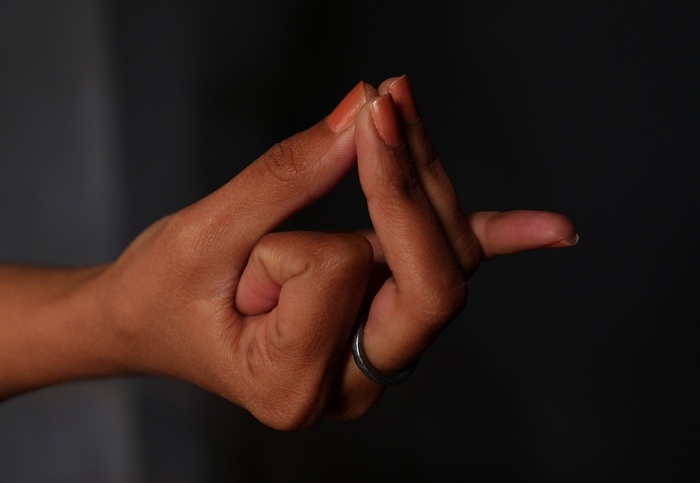
To practice hridaya mudra, sit with your palms facing up. Next, bend your index fingers so that their tips touch the base of each thumb. Then, join the tips of your thumbs, middle fingers, and ring fingers on each hand. Your little fingers will remain extended.
Apart from strengthening the heart chakra, hridaya mudra (also known as apana vayu mudra) is used therapeutically for heart-related diseases, heart-attack prevention, and as a remedy for anxiety, respiratory issues, and digestive problems.
The following yoga postures and practices direct energy to anahata chakra. This helps to cleanse, purify, or balance the heart area ‒ physically and metaphorically. By breathing deeply and staying present with your heart center, you will enhance the benefits of each practice.

Stand on your knees with your legs hip-distance apart. Place your hands on your lower back and guide your elbows towards each other to expand throughout the chest area. Begin to slowly bend backward, opening your heart to the sky. Then, take your gaze up and release your head back (unless you have neck issues). You can leave your hands on your lower back or place them on your heels for a deeper backbend. Breathe deeply and direct your breath towards your heart. Use your hands on your lower back for support when releasing this posture.
Puppy pose is so beneficial for the heart-chakra area that it’s also called anahatasana, or melting heart pose. To practice this asana, begin on your hands and knees with a neutral spine. From here, walk your fingertips out in front of you. Reach out as far as you can. Then envision your heart melting towards the Earth as if you have an opening in your chest and lower back. As you do this, keep your hips lifted and directly over your knees. Your forehead and the tops of your feet can rest on the ground. Breathe in this posture for as long as is comfortable.

Lie on your stomach with your legs together or hip-distance apart. Place your forearms on the ground in front of you with your fingers pointed forward and your elbows directly underneath your shoulders. Then, gently peel your upper body off the ground. Relax your shoulders back and gaze forward or slightly up. Focus your awareness on your heart center and the space between your shoulder blades.
For those familiar with yoga, reverse warrior pose, cow face pose, and backbends also benefit anahata chakra.
In addition to the previously-mentioned ways of connecting with anahata chakra, it’s possible to work through heart chakra imbalances on your own or with a professional healer. Further chakra healing practices include:
Practitioners in fields such as reiki, emotion-focused therapy (EFT), Chinese medicine, and hypnosis can identify and treat issues related to the heart center.
As previously mentioned, anahata chakra governs our respiratory and circulatory systems and is associated with the element of air. Thus, controlling your breath (your “air”) in ways that stimulate blood flow throughout the body is healthy for the heart chakra.
Various types of breathwork can help to open your heart including: traditional yogic breathing techniques (pranayama), Wim Hof breathing, shamanic breathing practices, and holotropic breathwork. However, if you’re new to breathwork, it’s best to begin with professional guidance.

Eating vegetables, particularly dark green ones, supports anahata health. Fresh juices and smoothies (especially those with green superfoods like moringa or spirulina), green fruits, fresh herbs, and green tea also nourish the heart. Some ideas of green foods to incorporate into your diet include: leafy greens, broccoli, asparagus, peas, Brussels sprouts, spring onion, avocado, kiwi fruit, green apples, lime, mint, basil, parsley, cilantro, and rosemary.
Additionally, raw cacao is beneficial for the heart, both physically and energetically. The chemical compounds in unprocessed cacao enhance feelings of euphoria and love, combat depression, and increase blood flow and oxygen to the heart. Cacao in the form of a warm beverage, when sipped slowly, is especially nourishing to the body, mind, and energetic heart.

Each chakra corresponds to a vibrational frequency that can be influenced by sound. Therefore, sound healing instruments like singing bowls, gongs, or tuning forks can balance the heart chakra. You can also use your voice to connect with your chakras through the practice of chakra toning. The heart chakra corresponds to the note of “F,” and the Solfeggio frequency of 639 Hz.
With any healing practice, remember that the most effective way to balance your chakras (and, therefore, your entire being) is through intention and a healthy lifestyle.

Hello. Thanks for visiting UniGuide. My name is Kristen and I started UniGuide as a tribute to nature, animals, and spiritual exploration. I hope you enjoy your experience here!
UniGuide is dedicated to nature and animal lovers, spiritual seekers, and mythology fans.
©2024 UniGuide Media LLC
All Rights Reserved.
UniGuide participates in affiliate programs in which I may earn a small commission if you buy products you link to from UniGuide. Please see my Disclosures for details.

I donate 10% of UniGuide’s profits to animal welfare, wildlife conservation, and environmental charities. Learn more on About UniGuide.
UniGuide Media LLC
1001 Bridgeway Ave. #145
Sausalito, CA 94965
| Cookie | Duration | Description |
|---|---|---|
| cookielawinfo-checkbox-analytics | 11 months | This cookie is set by GDPR Cookie Consent plugin. The cookie is used to store the user consent for the cookies in the category "Analytics". |
| cookielawinfo-checkbox-functional | 11 months | The cookie is set by GDPR cookie consent to record the user consent for the cookies in the category "Functional". |
| cookielawinfo-checkbox-necessary | 11 months | This cookie is set by GDPR Cookie Consent plugin. The cookies is used to store the user consent for the cookies in the category "Necessary". |
| cookielawinfo-checkbox-others | 11 months | This cookie is set by GDPR Cookie Consent plugin. The cookie is used to store the user consent for the cookies in the category "Other. |
| cookielawinfo-checkbox-performance | 11 months | This cookie is set by GDPR Cookie Consent plugin. The cookie is used to store the user consent for the cookies in the category "Performance". |
| viewed_cookie_policy | 11 months | The cookie is set by the GDPR Cookie Consent plugin and is used to store whether or not user has consented to the use of cookies. It does not store any personal data. |